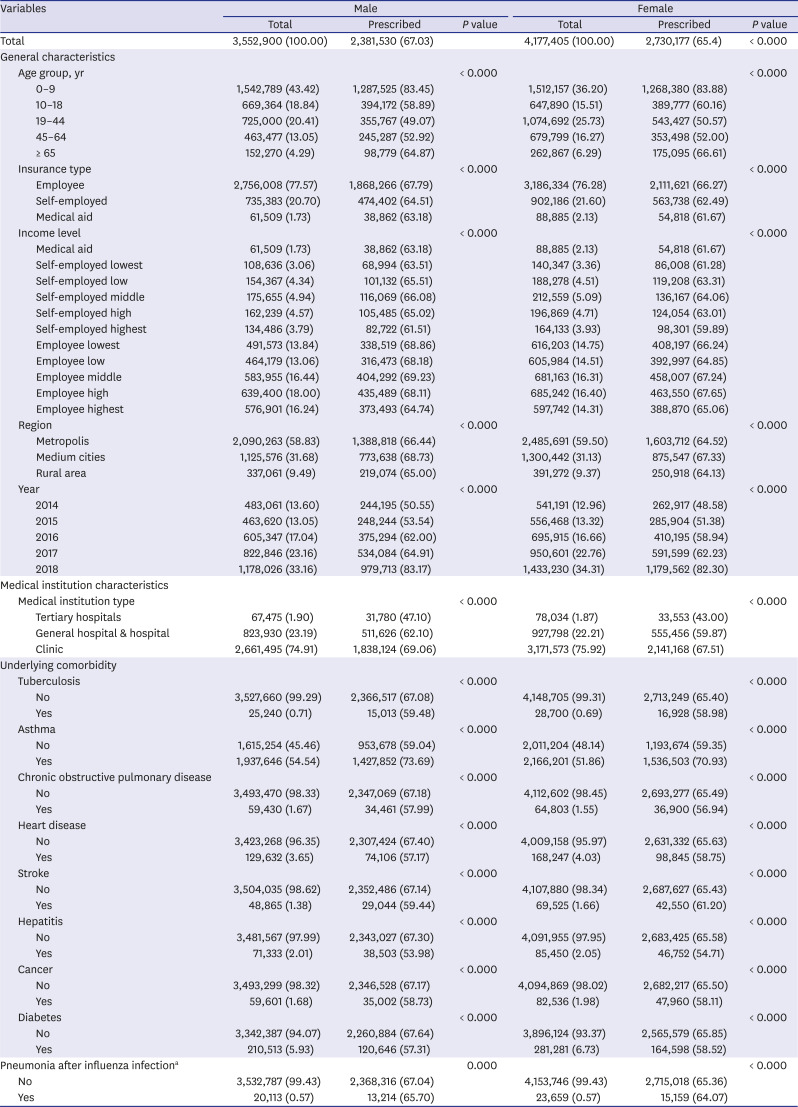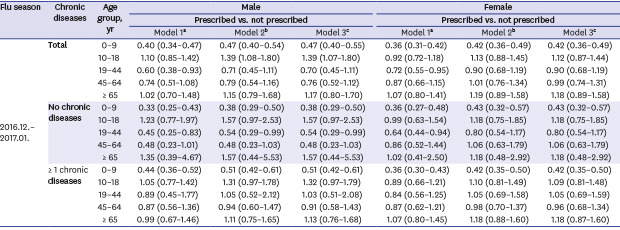2. Baek JH, Seo YB, Choi WS, Kee SY, Jeong HW, Lee HY, et al. Guideline on the prevention and control of seasonal influenza in healthcare setting. Korean J Intern Med. 2014; 29(2):265–280. PMID:
24648817.

3. Wright PF, Kirkland KB, Modlin JF. When to consider the use of antibiotics in the treatment of 2009 H1N1 influenza-associated pneumonia. N Engl J Med. 2009; 361(24):e112. PMID:
19940288.

4. Heo JY, Song JY, Noh JY, Choi MJ, Yoon JG, Lee SN, et al. Effects of influenza immunization on pneumonia in the elderly. Hum Vaccin Immunother. 2018; 14(3):744–749. PMID:
29135343.

5. Ryu SW, Suh IB, Ryu SM, Shin KS, Kim HS, Kim J, et al. Comparison of three rapid influenza diagnostic tests with digital readout systems and one conventional rapid influenza diagnostic test. J Clin Lab Anal. 2018; 32(2):e22234.

6. Almond MH, McAuley DF, Wise MP, Griffiths MJ. Influenza-related pneumonia. Clin Med (Lond). 2012; 12(1):67–70. PMID:
22372228.

7. Rothberg MB, Haessler SD, Brown RB. Complications of viral influenza. Am J Med. 2008; 121(4):258–264. PMID:
18374680.

8. Choi WS, Lee J, Lee HY, Baek JH, Kim YK, Kee SY, et al. Clinical practice guideline for antiviral treatment and chemoprophylaxis of seasonal influenza. Infect Chemother. 2012; 44(4):233–249.

11. Garg S, Jain S, Dawood FS, Jhung M, Pérez A, D'Mello T, et al. Pneumonia among adults hospitalized with laboratory-confirmed seasonal influenza virus infection-United States, 2005-2008. BMC Infect Dis. 2015; 15:369. PMID:
26307108.

12. Simmerman JM, Chittaganpitch M, Levy J, Chantra S, Maloney S, Uyeki T, et al. Incidence, seasonality and mortality associated with influenza pneumonia in Thailand: 2005-2008. PLoS One. 2009; 4(11):e7776. PMID:
19936224.

13. Chu S, Park SJ, Koo SM, Kim YK, Kim KU, Uh ST, et al. Incidence and risk factors of pneumonia in hospitalized patients with seasonal influenza A or B. Tuberc Respir Dis. 2017; 80(4):392–400.

14. Kang SH, Cheong HJ, Song JY, Noh JY, Jeon JH, Choi MJ, et al. Analysis of risk factors for severe acute respiratory infection and pneumonia and among adult patients with acute respiratory illness during 2011-2014 influenza seasons in Korea. Infect Chemother. 2016; 48(4):294–301. PMID:
27883375.

15. Peters PH, Moscona A, Schulman KL, Barr CE. Study of the impact of oseltamivir on the risk for pneumonia and other outcomes of influenza, 2000-2005. Medscape J Med. 2008; 10(6):131. PMID:
18679536.
16. Nordstrom BL, Sung I, Suter P, Szneke P. Risk of pneumonia and other complications of influenza-like illness in patients treated with oseltamivir. Curr Med Res Opin. 2005; 21(5):761–768. PMID:
15969875.

17. Gums JG, Pelletier EM, Blumentals WA. Oseltamivir and influenza-related complications, hospitalization and healthcare expenditure in healthy adults and children. Expert Opin Pharmacother. 2008; 9(2):151–161. PMID:
18201141.

18. Treanor JJ, Hayden FG, Vrooman PS, Barbarash R, Bettis R, Riff D, et al. Efficacy and safety of the oral neuraminidase inhibitor oseltamivir in treating acute influenza: a randomized controlled trial. JAMA. 2000; 283(8):1016–1024. PMID:
10697061.
19. Kaiser L, Wat C, Mills T, Mahoney P, Ward P, Hayden F. Impact of oseltamivir treatment on influenza-related lower respiratory tract complications and hospitalizations. Arch Intern Med. 2003; 163(14):1667–1672. PMID:
12885681.

20. Blumentals WA, Schulman KL. Impact of oseltamivir on the incidence of secondary complications of influenza in adolescent and adult patients: results from a retrospective population-based study. Curr Med Res Opin. 2007; 23(12):2961–2970. PMID:
17939881.

21. Whitley RJ, Hayden FG, Reisinger KS, Young N, Dutkowski R, Ipe D, et al. Oral oseltamivir treatment of influenza in children. Pediatr Infect Dis J. 2001; 20(2):127–133. PMID:
11224828.

22. Barr CE, Schulman K, Iacuzio D, Bradley JS. Effect of oseltamivir on the risk of pneumonia and use of health care services in children with clinically diagnosed influenza. Curr Med Res Opin. 2007; 23(3):523–531. PMID:
17355734.

23. Hedrick JA, Barzilai A, Behre U, Henderson FW, Hammond J, Reilly L, et al. Zanamivir for treatment of symptomatic influenza A and B infection in children five to twelve years of age: a randomized controlled trial. Pediatr Infect Dis J. 2000; 19(5):410–417. PMID:
10819336.

24. Singh S, Barghoorn J, Bagdonas A, Adler J, Treanor J, Kinnersley N, et al. Clinical benefits with oseltamivir in treating influenza in adult populations : results of a pooled and subgroup analysis. Clin Drug Investig. 2003; 23(9):561–569.
25. Welliver R, Monto AS, Carewicz O, Schatteman E, Hassman M, Hedrick J, et al. Effectiveness of oseltamivir in preventing influenza in household contacts: a randomized controlled trial. JAMA. 2001; 285(6):748–754. PMID:
11176912.
26. Hayden FG, Belshe R, Villanueva C, Lanno R, Hughes C, Small I, et al. Management of influenza in households: a prospective, randomized comparison of oseltamivir treatment with or without postexposure prophylaxis. J Infect Dis. 2004; 189(3):440–449. PMID:
14745701.

27. Lalezari J, Campion K, Keene O, Silagy C. Zanamivir for the treatment of influenza A and B infection in high-risk patients: a pooled analysis of randomized controlled trials. Arch Intern Med. 2001; 161(2):212–217. PMID:
11176734.
28. Monto AS, Webster A, Keene O. Randomized, placebo-controlled studies of inhaled zanamivir in the treatment of influenza A and B: pooled efficacy analysis. J Antimicrob Chemother. 1999; 44 Suppl B:23–29. PMID:
10877459.
29. Monto AS, Pichichero ME, Blanckenberg SJ, Ruuskanen O, Cooper C, Fleming DM, et al. Zanamivir prophylaxis: an effective strategy for the prevention of influenza types A and B within households. J Infect Dis. 2002; 186(11):1582–1588. PMID:
12447733.









 PDF
PDF Citation
Citation Print
Print




 XML Download
XML Download